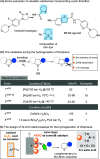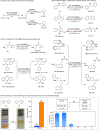Unlocking a Nano-Aluminum Oxide Lewis Acid Layer as the Electrocatalyst for Hydrogenation of Thiophene and Other Arenes
- PMID: 40560765
- PMCID: PMC12257536
- DOI: 10.1021/jacs.5c06034
Unlocking a Nano-Aluminum Oxide Lewis Acid Layer as the Electrocatalyst for Hydrogenation of Thiophene and Other Arenes
Abstract
Owing to the ready formation of an insulating oxide layer, there is an intrinsic obstacle to the use of aluminum material as the cathode in the electrocatalytic reaction. In this report, a new Al-based material with a surface aluminum oxide/chloride nanolayer (nAlClO@Al) is prepared. Via the quantum tunneling effect, this material realizes conductivity through the nano-Al-O layer. This material exhibits unusual inertness toward the hydrogen evolution reaction, leaving a wide reduction window for the substrate. Primed with the native Lewis acidity of the Al-Cl structure, this material achieves the electrocatalytic hydrogenation of thiophenes with up to >95% conversion, >95% selectivity, and 90% Faraday efficiency. This catalysis is applicable to heteroarene and benzene rings. In particular, the chemoselectivity is controlled by the nAlClO@Al catalyst instead of the substrate, which is complementary to electrochemical Birch chemistry.
Figures








Similar articles
-
Antibiotics and antiseptics for surgical wounds healing by secondary intention.Cochrane Database Syst Rev. 2016 Mar 29;3(3):CD011712. doi: 10.1002/14651858.CD011712.pub2. Cochrane Database Syst Rev. 2016. PMID: 27021482 Free PMC article.
-
Dressings and topical agents for treating pressure ulcers.Cochrane Database Syst Rev. 2017 Jun 22;6(6):CD011947. doi: 10.1002/14651858.CD011947.pub2. Cochrane Database Syst Rev. 2017. PMID: 28639707 Free PMC article.
-
[Health technology assessment report. Use of liquid-based cytology for cervical cancer precursors screening].Epidemiol Prev. 2012 Sep-Oct;36(5 Suppl 2):e1-e33. Epidemiol Prev. 2012. PMID: 23139163 Italian.
-
A rapid and systematic review of the clinical effectiveness and cost-effectiveness of paclitaxel, docetaxel, gemcitabine and vinorelbine in non-small-cell lung cancer.Health Technol Assess. 2001;5(32):1-195. doi: 10.3310/hta5320. Health Technol Assess. 2001. PMID: 12065068
-
The effect of sample site and collection procedure on identification of SARS-CoV-2 infection.Cochrane Database Syst Rev. 2024 Dec 16;12(12):CD014780. doi: 10.1002/14651858.CD014780. Cochrane Database Syst Rev. 2024. PMID: 39679851 Free PMC article.
References
-
- Gu X., Li X., Xie J., Zhou Q.. Recent Progress in Homogeneous Catalytic Hydrogenation of Esters. Acta Chim. Sinica. 2019;77:598–612. doi: 10.6023/A19050166. - DOI
LinkOut - more resources
Full Text Sources

